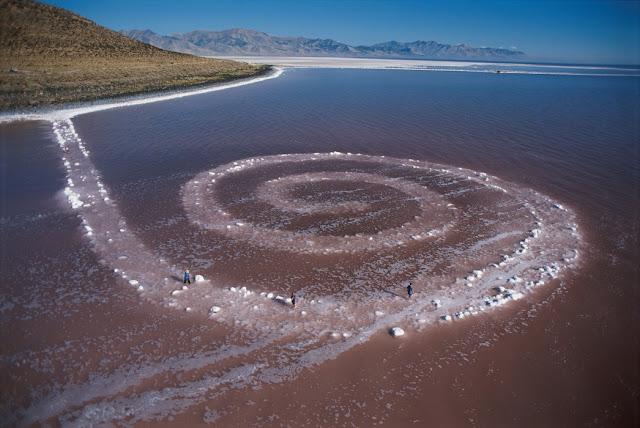Reflections on Smithson (#1)
Any
critic who says he is concerned with “self,” implies that art is in some way
united with “character,” or “personality,” or “individuality.” Self-criticism
never is concerned with art, but only with criticizing the self. Art is not
self.
—Robert
Smithson
The
woman who presents herself to the spectator as a ‘picture’ forever arranged is,
for the contemplative mind, the chiefest danger.
—Djuna
Barnes
From roughly 1965 until 1972, Robert
Smithson exuded an enigmatic gravity in the American art world, and his
writings are as substantial as his visual work: his Non-Sites, his language
art, and his earthworks, including the seminal Spiral Jetty. Along with
these aesthetic monoliths, Smithson produced an impressive collection of
essays, reviews, responses, think-pieces, and poetry. He commented on his peers’ works, and on critical
interventions like Michael Fried’s controversial “Art and Objecthood.” Taken as a whole, his Collected Writings represent a significant body of work and
contribution to the development of visual aesthetics after World War II, a time
when artistic creation was undergoing a profound and unprecedented
transformation. Breaking away from conventional
bounds of framing and institutionalism, postwar art expanded itself, formally
and thematically, into new and unstable ecologies.
At the time of his death, Smithson
was arguably at the height of his career, having completed his Spiral Jetty in 1970 and at the time
working on ambitious plans for new artistic sites. The scope of his visions was not wholly unparalleled;
Michael Heizer’s ongoing project, City,
is of an even greater scale than any of Smithson’s completed works (Heizer
started the project in 1972, the year Smithson died). But the scope of his speculative imaginings
remains largely unchallenged, or unchallenged until recently. Put simply, Smithson lamented the calcifying
conventions that obstructed artistic creativity—the demands of the museum, the geometrical
banality of framing, and the sterility of timelessness. For Smithson, paintings hanging in museums
partook of a dull temporality, carving a window out of time in which they sat
unchanging throughout entire lifespans of spectators. The Mona
Lisa may be historically significant, but its aesthetic value is one of trivial
cultural praise. It dies for centuries
while people live. Where’s the art in
that?
Smithson wanted to know why an
artwork shouldn’t be temporally and spatially extended, why it had to be fixed in place as a painting or
sculpture. It’s clear that such limitations
respond to our interests not as artists but as consumers. We want the work to stay put so we can enjoy
it, and we want it in a museum so we can authenticate its value. It’s easier to enjoy art that way, to peruse
it at our leisure. But why the hell sure
art be easy? Why should it cater to our
comfort? Inquiring minds want to know,
and we pose it to our culture. Smithson’s
art was a response to this delimiting and stultifying reproduction of the
aesthetic commodity. Instead of images or
objects that hung neatly on a wall, Smithson demanded that we get off our asses
and travel.
Figure 1: Spiral Jetty (R. Smithson, 1970)
You can’t see the Spiral Jetty in a museum.
You need to drive to Utah, fill up a spare gas tank and keep it in your
trunk so you can refill on your way, since there aren’t any stations at the
site. You need to bring food, water, and
a pair of boots in case the lake rises—which it currently hasn’t, thanks to a
local drought. And that’s another key
aspect of Smithson’s work: it’s not immune to the climate. It doesn’t enjoy the calm, air-conditioned peacefulness
of MoMA or the Met. It’s geographical,
it changes with the earth. It evolves
with the strata. Works like Spiral Jetty are art precisely because
they’re exposed to time and place, because they’re subject to nonhuman
ecologies. Smithson wanted art to live, wanted it to breathe and choke, to
absorb and shrivel, soak, shake, and salivate.
Art can exist on scales vaster than empires, and more slow. It’s not bound to human perception.
“There’s no reason one shouldn’t look at
art through a telescope,” Smithson once wrote.
Can planets be art? Can
supernovas? Galaxies? This may not have been his exact point, but
the sentiment remains: art can be the size of a planet, it can have the
lifespan of a star, the expanse of galaxies.
Art isn’t the reflection or expression of human selfhood, identity, or
genius. It’s not here for our pleasure
or gratification. It’s neither the sign
of our accomplishments nor the measure of our worth. It doesn’t stand the test of time, for a thing
that stands the test of time is eternally dead, idealized, abstracted from its
history. Rather, art is the flux of time,
corruption and decay. It’s an alien form
that sinks away from us, signals its becoming with things not-us. Art is nonhumanity, non-self, refracted
through a momentary human glimpse into the onrushing fold, the dolly-zoom of
death.
Figure 2: Blind in the Valley of the Suicides (R. Smithson, 1962)



Comments
Post a Comment